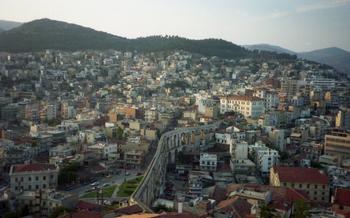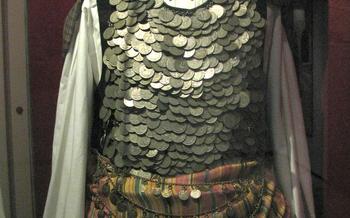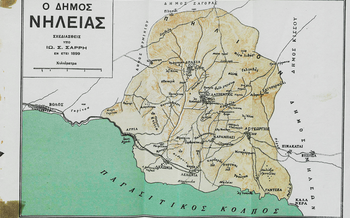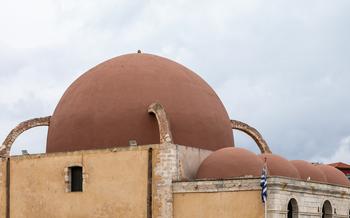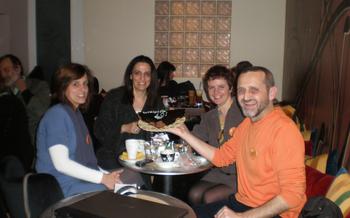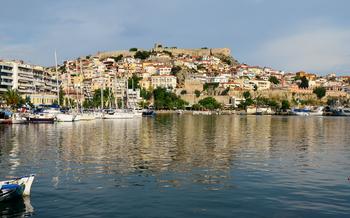
Petralona Cave in Halkidiki (a bit further away)
- Petralona Cave: A Hidden Gem in Halkidiki
- Transportation to Petralona Cave
- Guided Tours of Petralona Cave
- Exploring the Cave's Interior
- The Archanthropus Skull: A Remarkable Discovery
- Paleontological Treasures
- The Cave's Archaeological Importance
- Petralona Cave Museum: A Treasure Trove of History
- Surrounding Area: Halkidiki's Natural Beauty
- Accommodation Options
- Local Cuisine: Tantalizing Greek Flavors
- Planning Your Visit: Essential Tips
- Photography and Videography
- Accessibility Considerations
- Access for All
- Assisted Tours
- Insider Tip: Unveiling the Hidden Chamber
Petralona Cave: A Hidden Gem in Halkidiki
In the heart of Halkidiki, nestled amidst picturesque landscapes, lies the Petralona Cave, a hidden gem that invites you to delve into a world of ancient wonders and captivating discoveries. This remarkable cave has captured the attention of archaeologists and anthropologists worldwide for its rich archaeological significance and its remarkable geological formations.
History: Unveiling the Cave's Rich Archaeological Significance and Discoveries
Step into the realm of history as you uncover the fascinating tale of Petralona Cave. Its story begins in 1959, when a team of Greek archaeologists, led by Aris Poulianos, embarked on a groundbreaking excavation that would change our understanding of human evolution. Within the cave's depths, they unearthed a treasure trove of artifacts, including stone tools, animal bones, and the most significant discovery of all – the Archanthropus skull, a remarkably well-preserved hominid skull dating back an astonishing 700,000 years. This extraordinary find challenged established theories and shed new light on the origins of humankind.
Geology: Exploring the Cave's Fascinating Geological Formations
Petralona Cave is not only an archaeological marvel but also a geological wonder. Carved by the relentless forces of water over millions of years, the cave's intricate network of chambers and tunnels showcases a breathtaking array of stalactites and stalagmites, each a testament to the patient artistry of nature. Admire the towering columns, delicate curtains, and intricate chandeliers that adorn the cave's walls and ceilings, creating a mesmerizing spectacle that transports you to a subterranean world of wonder.
Anthropology: Delving into the Anthropological Findings and the Archanthropus Skull
The Archanthropus skull, discovered in Petralona Cave, has become a cornerstone of anthropological research. This remarkably preserved skull provides valuable insights into the evolutionary journey of our species, Homo sapiens. Its advanced features and the skull's age challenge traditional theories of human evolution and suggest the existence of a previously unknown hominid group that roamed the Earth hundreds of thousands of years ago. The ongoing study of the Archanthropus skull continues to fuel scientific debate and reshape our understanding of human origins.
Practicalities: Providing Essential Information for Visiting the Cave
To embark on your own journey of discovery, Petralona Cave is conveniently accessible from Thessaloniki, the vibrant capital of Macedonia. Regular bus services connect the city to the cave, making it an easy day trip. Alternatively, a scenic drive along the picturesque Halkidiki coast offers a delightful alternative. Once you arrive, knowledgeable guides are on hand to lead you through the cave's captivating chambers, regaling you with tales of its history, geology, and anthropological significance.
Transportation to Petralona Cave
Public Transport:
For those without their own transportation, reaching Petralona Cave via public transport is a breeze. Regular bus services operate from Thessaloniki, the capital of Central Macedonia, and from nearby cities like Polygyros and Nea Moudania. The journey from Thessaloniki takes approximately 2 hours and 30 minutes, with buses departing from the main bus station (KTEL Chalkidiki). Once in Petralona, the cave is just a short walk from the bus stop.
Driving Directions:
For those opting for the convenience of driving, Petralona Cave is easily accessible by car. From Thessaloniki, take the Egnatia Odos highway and exit at Nea Moudania. From there, follow the signs towards Petralona. The drive takes about 1 hour and 30 minutes. Along the way, you'll pass through picturesque villages and stunning landscapes, making the journey itself an enjoyable experience.
Guided Tours of Petralona Cave
Petralona Cave offers guided tours that provide an immersive and educational experience for visitors. These tours are conducted by knowledgeable guides who share insights into the cave's history, geology, and archaeological significance.
Available Tours
There are two main types of guided tours available: group tours and private tours. Group tours are typically conducted in English or Greek and are suitable for individuals or small groups who wish to join others for a shared experience. Private tours, on the other hand, are tailored to the specific interests and requirements of a particular group or individual. These tours can be conducted in a variety of languages, including English, French, German, and Italian.
Tour Highlights
During the guided tour, visitors will be taken through the cave's various chambers and passages, where they will encounter impressive geological formations, such as stalactites and stalagmites, as well as the famous Archanthropus skull. The guides will provide detailed explanations of the cave's history, from its formation millions of years ago to its discovery and excavation in the 20th century. They will also discuss the anthropological significance of the Archanthropus skull and its implications for our understanding of human evolution.
In addition to the cave itself, the tour also includes a visit to the Petralona Cave Museum, where visitors can learn more about the cave's history and findings through interactive exhibits, fossils, and multimedia presentations. The museum provides a deeper understanding of the cave's archaeological and paleontological significance, as well as its role in shaping our understanding of human history.
Exploring the Cave's Interior
Cave Structure:
The Petralona Cave is a vast and complex underground labyrinth, extending over several levels and chambers. As you enter the cave, you'll be greeted by a series of impressive chambers, each with its own unique characteristics. The main chamber, known as the "Great Hall," is a cavernous space that stretches over 100 meters in length and 50 meters in height. Its walls are adorned with intricate rock formations, stalactites, and stalagmites, creating a mesmerizing spectacle.
Stalactites and Stalagmites:
One of the most striking features of the Petralona Cave is its abundance of stalactites and stalagmites. These stunning formations, created by the slow dripping of water over thousands of years, take on a variety of shapes and sizes. Some resemble delicate icicles, while others form massive columns that reach from the floor to the ceiling. The interplay of light and shadow on these formations creates a captivating and otherworldly atmosphere.
The Archanthropus Skull: A Remarkable Discovery
In 1960, a groundbreaking discovery was made within the depths of Petralona Cave - the Archanthropus skull. This remarkably well-preserved skull, estimated to be over 700,000 years old, has captivated the scientific community and shed new light on human evolution.
The skull's discovery was a pivotal moment in anthropological history, as it challenged existing theories about human origins and migration. Its age indicated that hominids had inhabited Europe much earlier than previously believed, pushing back the timeline of human presence in the region.
The Archanthropus skull exhibits a unique blend of primitive and modern features, suggesting a transitional stage in human evolution. Its large braincase and prominent brow ridge are reminiscent of earlier hominid species, while its rounded shape and smaller teeth resemble those of modern humans.
This remarkable fossil has fueled debates among anthropologists and paleontologists, providing insights into the complex evolutionary journey that led to the emergence of Homo sapiens. The skull's discovery has solidified Petralona Cave's status as a significant archaeological site and a treasure trove of information about our ancient ancestors.
Paleontological Treasures
Petralona Cave is not only a treasure trove of archaeological discoveries but also a rich repository of paleontological wonders. As you delve deeper into the cave's chambers, you'll encounter a diverse array of fossils that provide tantalizing glimpses into the life forms that once inhabited this region.
Paleontologists have meticulously unearthed a remarkable collection of fossils, including the remains of prehistoric mammals, such as saber-toothed tigers, mammoths, and giant hyenas. These fossils offer valuable insights into the evolutionary history of these magnificent creatures and their adaptation to the ever-changing environment of the Pleistocene epoch.
But the paleontological significance of Petralona Cave extends far beyond its mammalian fossils. The cave has also yielded a wealth of bird fossils, representing species that no longer grace our skies. These avian remains, exquisitely preserved in the cave's sedimentary layers, provide ornithologists with crucial information about the diversification and extinction of bird species over millions of years.
In addition to fossils, Petralona Cave has revealed a treasure trove of ancient artifacts, including intricately crafted stone tools, animal bones bearing butchering marks, and remnants of prehistoric hearths. These artifacts silently testify to the presence of human inhabitants in the cave during different periods, shedding light on their hunting practices, tool-making techniques, and daily life in this subterranean realm.
The Cave's Archaeological Importance
Human Occupation: Petralona Cave has yielded evidence of human presence dating back to the Paleolithic era. Archaeological excavations have uncovered stone tools, animal bones, and hearths, indicating that the cave was used as a shelter and hunting site by early humans. Later, during the Neolithic period, the cave served as a settlement for agricultural communities, as evidenced by the discovery of pottery, agricultural tools, and domesticated animal remains.
Cultural Significance: The cave holds significant cultural importance as it is believed to have been a sacred site in ancient times. Numerous artifacts discovered within the cave, such as figurines, jewelry, and ritual objects, suggest that it was used for religious ceremonies and rituals. Moreover, the cave's proximity to Mount Athos, a center of Eastern Orthodox Christianity, has led to the belief that it may have been a place of pilgrimage and spiritual retreat for early Christian hermits.
Petralona Cave Museum: A Treasure Trove of History
The Petralona Cave Museum is a must-visit destination for anyone interested in the cave's rich history and archaeological significance. Located just a short walk from the cave entrance, the museum houses a fascinating collection of exhibits that bring the cave's story to life.
Exhibits That Transport You Back in Time
The museum's displays include an array of artifacts discovered within the cave, including fossils, tools, and remnants of prehistoric life. These artifacts provide valuable insights into the lives of the people who inhabited the cave thousands of years ago.
A highlight of the museum is the replica of the Archanthropus skull, which is displayed alongside a detailed explanation of its discovery and significance. Visitors can also learn about the cave's geological formations, its role in ancient rituals, and its connection to Greek mythology.
Interactive Displays for a Multisensory Experience
The Petralona Cave Museum features interactive multimedia presentations that enhance the visitor experience. These displays allow visitors to explore the cave's history and archaeological findings in a dynamic and engaging way.
Through virtual reality simulations, visitors can virtually step inside the cave and experience its breathtaking beauty and unique features. Interactive touchscreens provide detailed information about the cave's geology, paleontology, and anthropology.
Preserving and Presenting the Cave's Legacy
The Petralona Cave Museum plays a vital role in preserving and presenting the cave's findings to the public. The museum's exhibits are meticulously curated and presented in a way that is both informative and accessible.
By showcasing the cave's rich history and archaeological significance, the museum helps to raise awareness of this unique site and its importance to our understanding of human evolution and prehistory.
Surrounding Area: Halkidiki's Natural Beauty
Beyond the captivating allure of Petralona Cave, the region of Halkidiki beckons with its pristine natural beauty. Visitors can bask in the splendor of crystal-clear waters and golden sandy beaches that fringe the region's coastline, making it an ideal destination for relaxation and a refreshing escape. Bask in the sun's warmth, indulge in invigorating water sports, or simply soak in the tranquility of the picturesque shores.
Venturing inland from the coastal haven, one encounters charming traditional villages that provide a glimpse into Halkidiki's rich cultural heritage. These quaint settlements, nestled amidst verdant landscapes, exude a timeless allure, inviting visitors to delve into the authentic essence of Greek life. Take a leisurely stroll through their narrow cobblestone streets, admire the traditional architecture, and engage with the warm and welcoming locals who are eager to share their stories and traditions.
Accommodation Options
Petralona Cave's proximity to Thessaloniki and the beautiful Halkidiki region offers visitors a range of accommodation options. For those seeking convenience, several hotels are located near the cave. These hotels provide comfortable stays with easy access to the cave and other attractions.
For a more immersive experience, consider staying in one of the traditional villages surrounding the cave. These villages offer charming accommodations, such as small hotels, guesthouses, and apartments, that allow visitors to embrace the local culture and lifestyle. Opting for a village stay provides an opportunity to explore the region's rich history, sample local cuisine, and interact with friendly locals.
Some recommended hotels in close proximity to the cave include the Petralona Cave Hotel, the Petralona Village Hotel, and the Petralona Resort. For a unique experience, consider staying at the Archanthropus Museum Hotel, located within the Petralona Cave Museum complex. This hotel offers stunning views of the cave and the surrounding landscape.
Insider Tip: For a truly authentic experience, book a stay at a traditional guesthouse in one of the nearby villages. Many of these guesthouses are family-run and offer a warm and welcoming atmosphere, allowing visitors to connect with the local community and learn about their way of life.
Local Cuisine: Tantalizing Greek Flavors
A visit to Petralona Cave is not complete without savoring the region's delectable cuisine. Halkidiki is renowned for its fresh, locally sourced ingredients, and its dishes reflect the rich culinary traditions of Greece.
Must-try local delicacies include:
-
Moussaka: A hearty dish featuring layers of eggplant, minced meat, and a creamy béchamel sauce, baked to perfection.
-
Pastitsio: A baked pasta dish similar to moussaka, but with a filling of macaroni, minced meat, and a rich tomato sauce.
-
Souvlaki: Grilled meat skewers, usually made with lamb, pork, or chicken, served with pita bread, tomatoes, and onions.
-
Gyros: A popular street food consisting of grilled meat, typically pork or chicken, wrapped in pita bread with tomatoes, onions, and tzatziki sauce.
-
Horiatiki Salata: A refreshing Greek salad made with tomatoes, cucumbers, onions, feta cheese, and Kalamata olives, dressed with olive oil and oregano.
When it comes to tavernas and restaurants, Halkidiki offers a wide range of options:
-
To Steki tou Ilia: A traditional taverna in Petralona village, known for its delicious home-cooked Greek dishes and warm hospitality.
-
O Kyrios: A charming restaurant in Nea Moudania, serving fresh seafood and traditional Greek cuisine with a modern twist.
-
To Ouzeri tou Laki: A cozy ouzeri in Nea Skioni, offering a variety of small plates, or "meze," perfect for sharing and enjoying with a glass of ouzo.
Indulge in the tantalizing flavors of Halkidiki's cuisine and complete your Petralona Cave experience with a culinary adventure.
Planning Your Visit: Essential Tips
To make the most of your visit to the Petralona Cave, careful planning is crucial. Consider the following tips for an enriching and enjoyable experience:
Optimal Timing: Aim to visit the cave during the spring or fall, when the weather is pleasant and crowds are generally smaller. Avoid the peak summer months (July and August) if you prefer a quieter exploration. As for the time of day, mornings and early afternoons offer the most favorable conditions for exploration.
Duration: Plan to spend at least two to three hours at the Petralona Cave. This will allow you ample time to explore the cave's interior, take a guided tour, and visit the on-site museum. You can extend your stay if you choose to spend more time hiking or exploring the surrounding area.
Photography and Videography
Photography Guidelines:
Petralona Cave offers a unique opportunity to capture stunning images of its geological formations, archaeological discoveries, and the surrounding natural beauty. Photography and videography are generally permitted within the cave, except in certain designated areas where it may be restricted for conservation purposes. Visitors are kindly requested to adhere to these guidelines to ensure the preservation of the cave's fragile environment and respect for other visitors.
Capturing Memorable Moments:
To make the most of your photography experience, consider bringing a tripod for stable shots, especially in low-light conditions. A wide-angle lens can be helpful for capturing the cave's vast chambers and impressive stalactite and stalagmite formations. For close-up shots of fossils and artifacts, a macro lens can be beneficial. Remember to adjust your camera settings accordingly, experimenting with different shutter speeds and apertures to achieve optimal results.
Accessibility Considerations
Access for All
Petralona Cave has taken commendable steps to ensure accessibility for visitors with mobility impairments. Visitors can enjoy a comfortable and inclusive experience, thanks to well-maintained pathways, ramps, and handrails throughout the cave. The museum is also wheelchair accessible, allowing visitors to explore the exhibits and learn about the cave's history and discoveries. Additionally, the cave's staff is trained to assist visitors with special needs, providing support and ensuring a safe and enjoyable visit for everyone.
Assisted Tours
For visitors who require additional assistance, guided tours are available upon request. These tours are tailored to meet the specific needs of individuals or groups with mobility challenges. Visitors can arrange for an assisted tour when booking their tickets or by contacting the cave's management in advance. The guides are knowledgeable and experienced in providing assistance, ensuring a personalized and enriching experience for all visitors.
Insider Tip: Unveiling the Hidden Chamber
Beyond the main tourist route, Petralona Cave holds a secret chamber, accessible through a narrow passage that leads to a hidden realm of archaeological significance. This chamber, discovered during recent excavations, has revealed an abundance of artifacts, including stone tools, animal bones, and remnants of hearths, indicating human occupation dating back thousands of years. The ongoing research conducted in this chamber promises to shed even more light on the cave's rich history and the lives of its ancient inhabitants. Visitors who are curious and adventurous enough to venture into this hidden space can gain a deeper understanding of the cave's significance and its role in our understanding of human evolution and prehistory.

